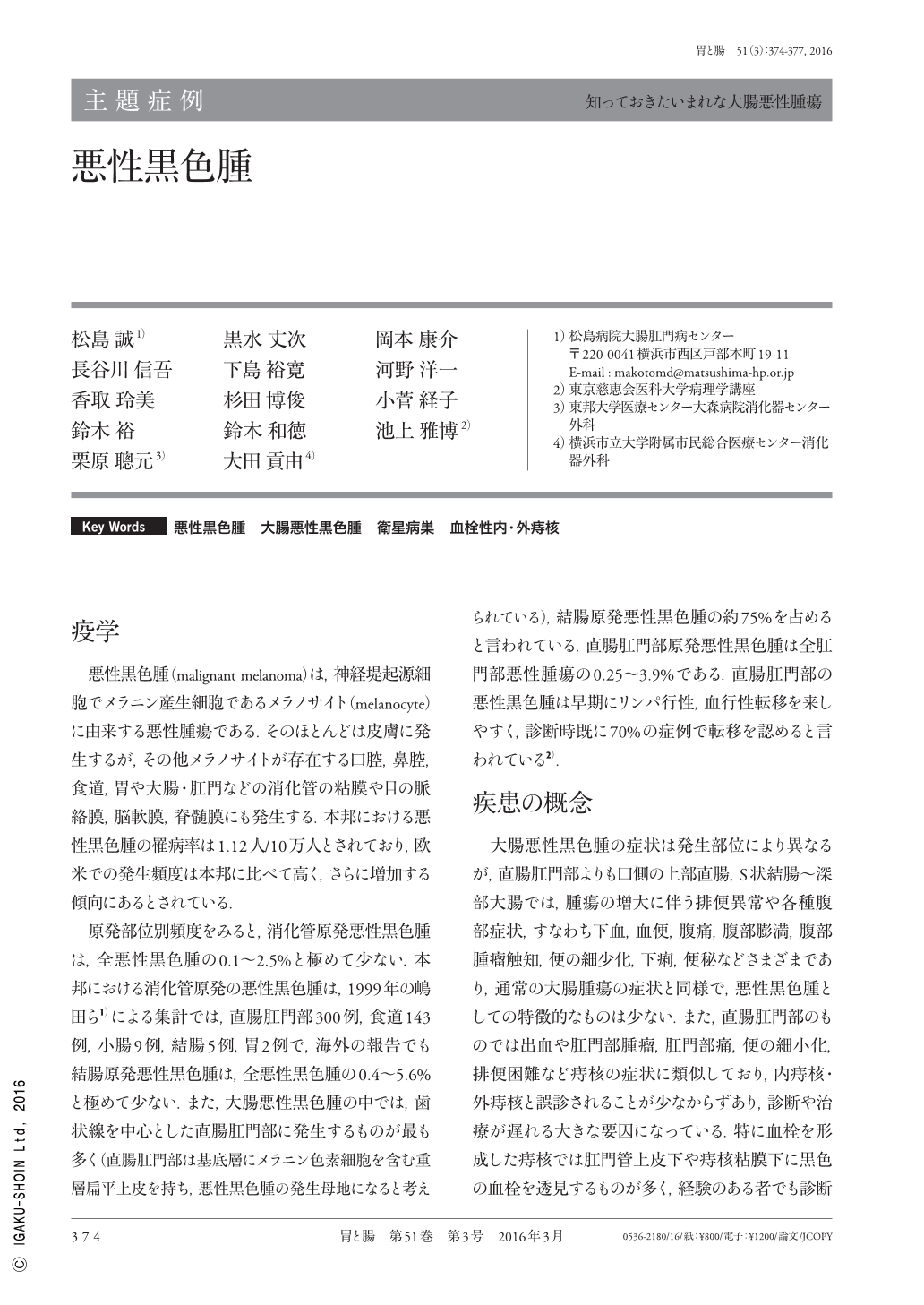2 0 0 0 悪性黒色腫
- 著者
- 松島 誠 黒水 丈次 岡本 康介 長谷川 信吾 下島 裕寛 河野 洋一 香取 玲美 杉田 博俊 小菅 経子 鈴木 裕 鈴木 和徳 池上 雅博 栗原 聰元 大田 貢由
- 出版者
- 医学書院
- 巻号頁・発行日
- pp.374-377, 2016-03-25
疫学 悪性黒色腫(malignant melanoma)は,神経堤起源細胞でメラニン産生細胞であるメラノサイト(melanocyte)に由来する悪性腫瘍である.そのほとんどは皮膚に発生するが,その他メラノサイトが存在する口腔,鼻腔,食道,胃や大腸・肛門などの消化管の粘膜や目の脈絡膜,脳軟膜,脊髄膜にも発生する.本邦における悪性黒色腫の罹病率は1.12人/10万人とされており,欧米での発生頻度は本邦に比べて高く,さらに増加する傾向にあるとされている. 原発部位別頻度をみると,消化管原発悪性黒色腫は,全悪性黒色腫の0.1〜2.5%と極めて少ない.本邦における消化管原発の悪性黒色腫は,1999年の嶋田ら1)による集計では,直腸肛門部300例,食道143例,小腸9例,結腸5例,胃2例で,海外の報告でも結腸原発悪性黒色腫は,全悪性黒色腫の0.4〜5.6%と極めて少ない.また,大腸悪性黒色腫の中では,歯状線を中心とした直腸肛門部に発生するものが最も多く(直腸肛門部は基底層にメラニン色素細胞を含む重層扁平上皮を持ち,悪性黒色腫の発生母地になると考えられている),結腸原発悪性黒色腫の約75%を占めると言われている.直腸肛門部原発悪性黒色腫は全肛門部悪性腫瘍の0.25〜3.9%である.直腸肛門部の悪性黒色腫は早期にリンパ行性,血行性転移を来しやすく,診断時既に70%の症例で転移を認めると言われている2).
1 0 0 0 OA MRSA感染耳に対するピオクタニン®局所投与の治療効果
- 著者
- 香山 智佳子 後藤 友佳子 長谷川 信吾 藤田 岳 丹生 健一
- 出版者
- Japan Otological Society
- 雑誌
- Otology Japan (ISSN:09172025)
- 巻号頁・発行日
- vol.18, no.1, pp.39-44, 2008-03-21 (Released:2011-06-17)
- 参考文献数
- 20
- 被引用文献数
- 1
Gentian violet (Pyoktanin) is known to have a potent antibacterial activity against Gram-positive bacteria including methicillin-resistantStaphylococcus aureus (MRSA).From November 2000 to August 2006, we have treated 91 patients for intractable ear infected with MRSA by topical treatment with gentian violet. There were 99 infected ears: 44 chronic otitis media, 11 otitis media with effusion treated with tympanostomy tube, 10 repetitive suppurative otitis media, 10 otitis externa, 8 postoperative discharging mastoid cavity for cholesteatoma, 6 cholesteatoma, 4 eosinophilic otitis media, 3 acute otitis media, 3 myringitis. The pathogens detected in those ears during the treatment period were as follows: MRSA in 92 ears, MRSA andP. aeruginosa7 ears. Topical treatment with gentian violet was performed 7.5 times on average. In the 92 ears (92.9%), topical treatment was performed 5.4 times on average. Noteworthily, 23 ears required only one treatment and 16 ears required twice, and this fact was suggesting that frequent treatments were not necessary to control the pathogens sensitive to gentian violet. This high cure rate (92/99) of the ear infected with MRSA also suggested that this treatment was especially effective for the treatment of MRSA infected ears.
